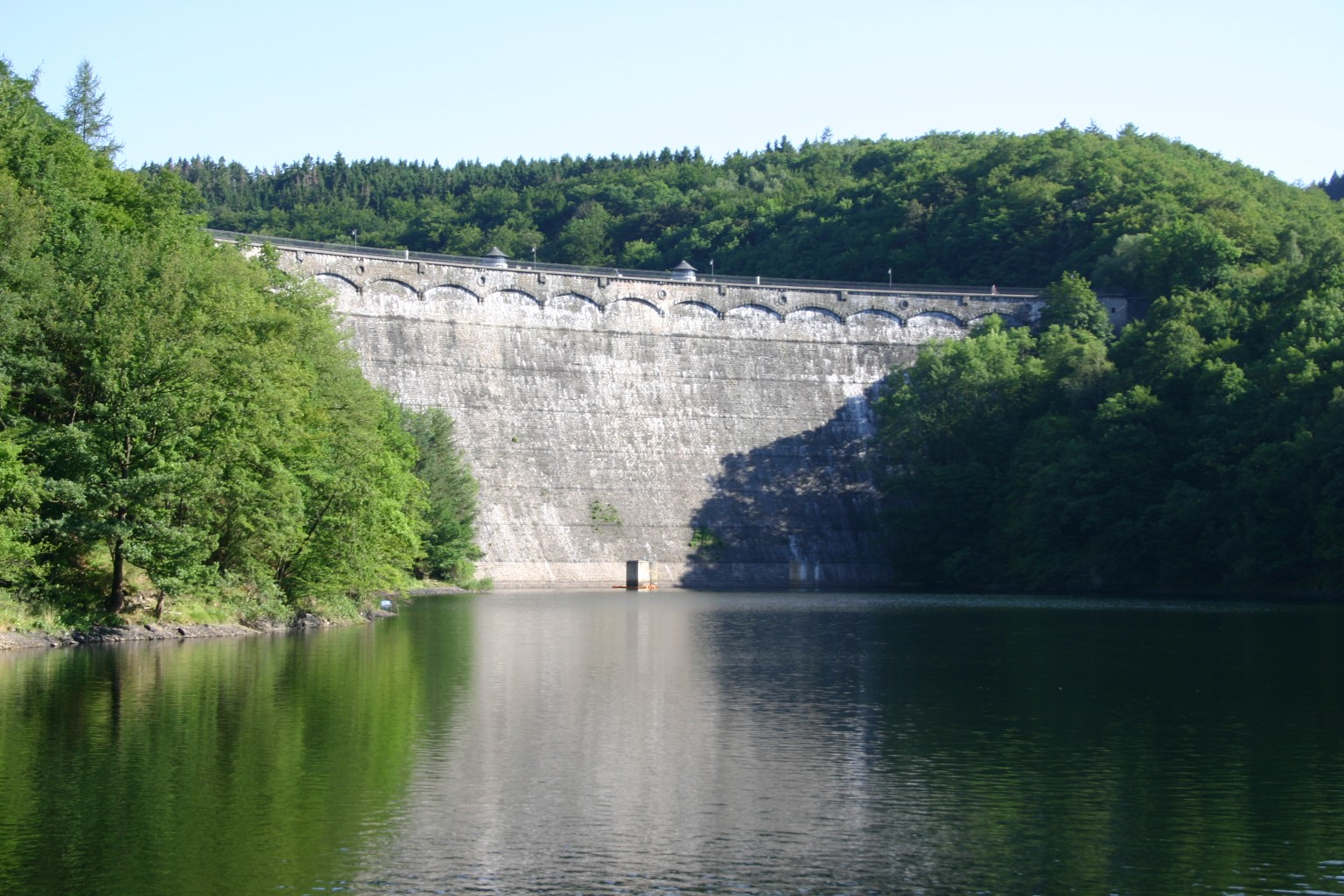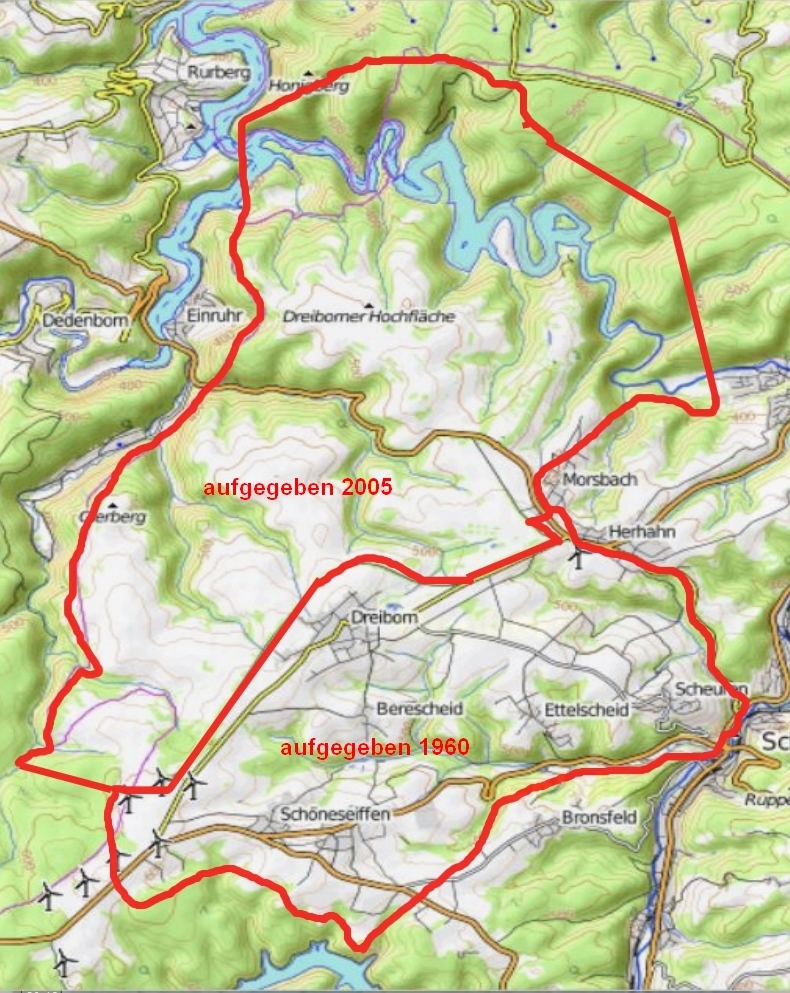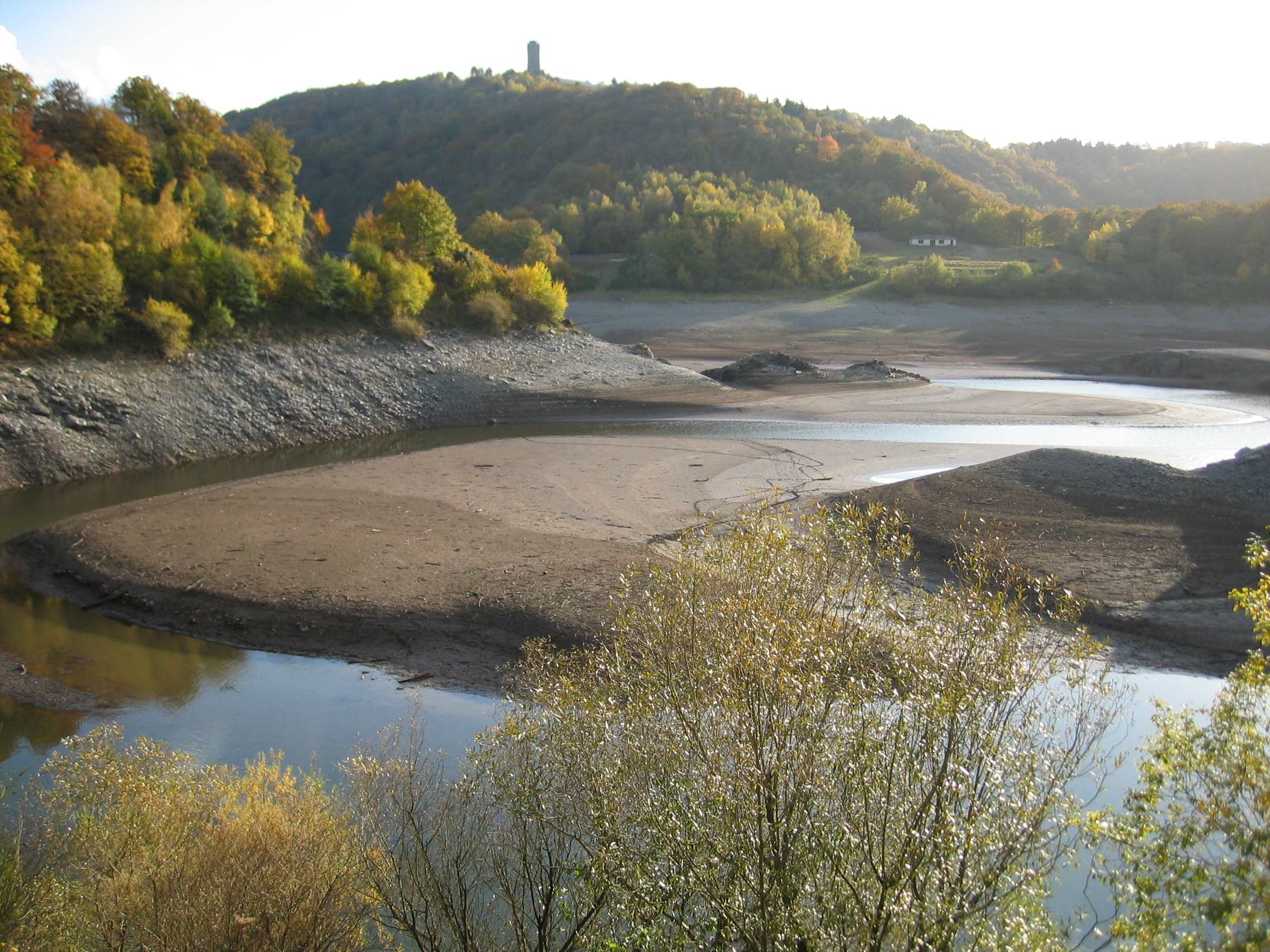Urft Dam on:
[Wikipedia]
[Google]
[Amazon]
The Urft Dam (german: Urfttalsperre) is a 58.50 metre high dam in the southwestern part of the state of

 The Urft barrier system that comprises the Urft Dam and Urft Reservoir is located in the
The Urft barrier system that comprises the Urft Dam and Urft Reservoir is located in the
 The Urft dam is a curved
The Urft dam is a curved

 The Urft Reservoir (''Urftstausee'' or ''Urftsee''), which when full is 7.85 km long according to the ''Deutsche Grundkarte'' map, although the straight-line distance from the head of the lake to the dam is only about 3.9 km), has a total area of 2.16 km² and holds up to 47.75 million cubic metres of water. The
The Urft Reservoir (''Urftstausee'' or ''Urftsee''), which when full is 7.85 km long according to the ''Deutsche Grundkarte'' map, although the straight-line distance from the head of the lake to the dam is only about 3.9 km), has a total area of 2.16 km² and holds up to 47.75 million cubic metres of water. The 
Information about the Urft Dam by the Eifel-Rur Water Board
Data sheet by the Eifel-Rur Water Board
(pdf file)
Urft Reservoir water level gauge
Dams of the Eifel
NRW dam information
(pdf file)
{{Authority control Dams in North Rhine-Westphalia RUrft Weirs Dams completed in 1905 1905 establishments in Germany
North Rhine-Westphalia
North Rhine-Westphalia (german: Nordrhein-Westfalen, ; li, Noordrien-Wesfale ; nds, Noordrhien-Westfalen; ksh, Noodrhing-Wäßßfaale), commonly shortened to NRW (), is a States of Germany, state (''Land'') in Western Germany. With more tha ...
in Germany. It was built in 1905. The dam impounds the River Urft
The Urft is a right-hand tributary of the Rur in the county of Euskirchen in the German state of North Rhine-Westphalia. It flows through the village of Urft in the municipality of Kall. The Urft rises in the North Eifel region of the Eifel M ...
in the district of Euskirchen
Euskirchen (; Ripuarian: ''Öskerche'') is a town in North Rhine-Westphalia, Germany, capital of the district Euskirchen. While Euskirchen resembles a modern shopping town, it also has a history dating back over 700 years, having been granted to ...
to create the Urft Reservoir (''Urftstausee''), 2.16 km² in area. The reservoir is also called the ''Urftsee'' (Lake Urft).
The Urft Dam, which was constructed during the period 1900 to 1905, and the Urft Reservoir, which was then the biggest reservoir in Europe, having belonged since 1993 to the Eifel-Rur Water Board (''Wasserverband Eifel-Rur'').
Location

Rur Eifel The Rur Eifel (german: Rureifel) lies in the district of Düren in the German state of North Rhine-Westphalia, and is a local recreation area from the regions of Cologne, Aachen, Düsseldorf, Krefeld, Mönchengladbach and Bonn. Its name comes from t ...
, a subdivision of the North Eifel The North Eifel (german: Nordeifel), the northern part of the Eifel, a low mountain range in Germany and East Belgium, comprises the following six sub-regions:
* Venn Foreland,
* Hohes Venn,
* Rur Eifel,
*Limestone Eifel,
* Our Valley and
* High Eif ...
region, south of the Kermeter
The Kermeter is an upland region, up to , which is part of the Rureifel within the North Eifel in the districts of Aachen, Düren and Euskirchen in the southwestern part of the state of North Rhine-Westphalia in Germany.
The Kermeter ridge is ...
ridge, north-northeast of the Dreiborn Plateau between Simmerath
Simmerath is a municipality in the district of Aachen, in North Rhine-Westphalia, Germany. It is located approximately 20 km south-east of Aachen, near the border to Belgium
Belgium, ; french: Belgique ; german: Belgien officially ...
- Rurberg (in the neighbouring region of Aachen
Aachen ( ; ; Aachen dialect: ''Oche'' ; French and traditional English: Aix-la-Chapelle; or ''Aquisgranum''; nl, Aken ; Polish: Akwizgran) is, with around 249,000 inhabitants, the 13th-largest city in North Rhine-Westphalia, and the 28th- ...
) to the west-northwest and Schleiden
Schleiden is a town in North Rhine-Westphalia, Germany. It lies in the Eifel hills, in the district of Euskirchen, and has 12,998 inhabitants as of 30 June 2017. Schleiden is connected by a tourist railway to Kall, on the Eifel Railway between Col ...
-Gemünd
Gemünd is a municipality in the district of Bitburg-Prüm, in Rhineland-Palatinate, western Germany
Germany,, officially the Federal Republic of Germany, is a country in Central Europe. It is the second most populous country in Eu ...
( Euskirchen district) to the east-southeast. It lies immediately above the Obersee, the main pre-basin (''Vorbecken'') of the Rur Reservoir, in which the waters of the Urft and Rur
The Rur or Roer (german: Rur ; Dutch and li, Roer, , ; french: Rour) is a major river that flows through portions of Belgium, Germany and the Netherlands. It is a right (eastern) tributary to the Meuse ( nl, links=no, Maas). About 90 perce ...
are impounded, and is situated within the Eifel National Park
The Eifel National Park (german: Nationalpark Eifel) is the 14th national park in Germany and the first in North Rhine-Westphalia. The park was founded in 2004, and is classified as a "national park in development".
Eifel National Park is par ...
, founded in 2004, which is in turn surrounded by the Hohes Venn-Eifel Nature Park.
Dam wall
 The Urft dam is a curved
The Urft dam is a curved gravity dam
A gravity dam is a dam constructed from concrete or stone masonry and designed to hold back water by using only the weight of the material and its resistance against the foundation to oppose the horizontal pressure of water pushing against it. ...
with its convex side facing upstream and an earth embankment (an ''Intze Wedge'') on the reservoir side that reaches to about half the height of the dam wall. It is situated around 6.8 kilometres, as the crow flies, west-northwest of Gemünd
Gemünd is a municipality in the district of Bitburg-Prüm, in Rhineland-Palatinate, western Germany
Germany,, officially the Federal Republic of Germany, is a country in Central Europe. It is the second most populous country in Eu ...
, the northern part of the town of Schleiden
Schleiden is a town in North Rhine-Westphalia, Germany. It lies in the Eifel hills, in the district of Euskirchen, and has 12,998 inhabitants as of 30 June 2017. Schleiden is connected by a tourist railway to Kall, on the Eifel Railway between Col ...
in Euskirchen district.
The Urft Dam was built between 1900 and 1905. The overall plan for the dam was developed by Prof. Dr. Otto Intze from Aachen
Aachen ( ; ; Aachen dialect: ''Oche'' ; French and traditional English: Aix-la-Chapelle; or ''Aquisgranum''; nl, Aken ; Polish: Akwizgran) is, with around 249,000 inhabitants, the 13th-largest city in North Rhine-Westphalia, and the 28th- ...
and built according to the so-called Intze Principle; Intze also led the construction. To build the dam wall a railway line was laid from Gemünd to the site to transport men and materiel. The barrage is made of rubble stone
Rubble stone is rough, uneven building stone not laid in regular courses. It may fill the core of a wall which is faced with unit masonry such as brick or ashlar. Analogously, some medieval cathedral walls are outer shells of ashlar with an i ...
composed of greywacke
Greywacke or graywacke (German ''grauwacke'', signifying a grey, earthy rock) is a variety of sandstone generally characterized by its hardness, dark color, and poorly sorted angular grains of quartz, feldspar, and small rock fragments or lit ...
and slate
Slate is a fine-grained, foliated, homogeneous metamorphic rock derived from an original shale-type sedimentary rock composed of clay or volcanic ash through low-grade regional metamorphism. It is the finest grained foliated metamorphic rock. ...
that was quarried locally and rises 58.5 metres above its base (''Gründungssohle''). At its crown, it is around 226 metres long and 6 metres wide, and is 50.5 metres wide at its foot. The Urft Dam was also the highest in Europe until the construction of the Bober Dam in the Giant Mountains
The Giant Mountains, Krkonoše or Karkonosze (Czech: , Polish: , german: Riesengebirge) are a mountain range located in the north of the Czech Republic and the south-west of Poland, part of the Sudetes mountain system (part of the Bohemian Massif ...
of Silesia
Silesia (, also , ) is a historical region of Central Europe that lies mostly within Poland, with small parts in the Czech Republic and Germany. Its area is approximately , and the population is estimated at around 8,000,000. Silesia is split ...
in 1912.
On its completion, the Urft Dam became the model for many other projects at home and abroad after water management
Water resources are natural resources of water that are potentially useful for humans, for example as a source of drinking water supply or irrigation water. 97% of the water on the Earth is salt water and only three percent is fresh water; slightl ...
for industrialization
Industrialisation ( alternatively spelled industrialization) is the period of social and economic change that transforms a human group from an agrarian society into an industrial society. This involves an extensive re-organisation of an econo ...
became increasingly important after the end of the 19th century. The trial impoundment of the river began in November 1904, its use in water management started on 26 August 1905.
North of the Urft Dam and separated from it by the base of a narrow peninsula is the spillway
A spillway is a structure used to provide the controlled release of water downstream from a dam or levee, typically into the riverbed of the dammed river itself. In the United Kingdom, they may be known as overflow channels. Spillways ensure tha ...
in the shape of an overflow weir with a maximum width of 91 metres which cascades down a total of 33 steps. Within the dam at an interval of 2.5 metres are vertical clay
Clay is a type of fine-grained natural soil material containing clay minerals (hydrous aluminium phyllosilicates, e.g. kaolin, Al2 Si2 O5( OH)4).
Clays develop plasticity when wet, due to a molecular film of water surrounding the clay par ...
-filled tubes that drain away the water that seeps into the dam wall.
Several bottom outlet towers provide access to inspection walkways at two different depths that enable the state of Urft Dam to be checked. The lower inspection gallery runs along its base joint. From 1994 to 2000 the barrage was thoroughly renovated. Among other things, a problem with the uplift pressure was resolved. It was also given two new inspection galleries that were driven using blasting techniques, which have a total length of 320 metres, are an average of 3.10 metres high and 2.40 metres wide, as well as new sealing and drainage and numerous measuring devices.
The Eifel-Rur Water Board celebrated the 100th anniversary of the opening of the Urft Dam on 26 August 2005.
Since the Rur Dam was completed, the Urft dam not only impounds water on its upstream side, but also impounds the waters of the Rur Reservoir (also called the Obersee) on its downstream side up to a depth of 12 metres.
Reservoir

 The Urft Reservoir (''Urftstausee'' or ''Urftsee''), which when full is 7.85 km long according to the ''Deutsche Grundkarte'' map, although the straight-line distance from the head of the lake to the dam is only about 3.9 km), has a total area of 2.16 km² and holds up to 47.75 million cubic metres of water. The
The Urft Reservoir (''Urftstausee'' or ''Urftsee''), which when full is 7.85 km long according to the ''Deutsche Grundkarte'' map, although the straight-line distance from the head of the lake to the dam is only about 3.9 km), has a total area of 2.16 km² and holds up to 47.75 million cubic metres of water. The River Urft
The Urft is a right-hand tributary of the Rur in the county of Euskirchen in the German state of North Rhine-Westphalia. It flows through the village of Urft in the municipality of Kall. The Urft rises in the North Eifel region of the Eifel M ...
flows through it from east to west. It is located within the district of Euskirchen south of the Kermeter
The Kermeter is an upland region, up to , which is part of the Rureifel within the North Eifel in the districts of Aachen, Düren and Euskirchen in the southwestern part of the state of North Rhine-Westphalia in Germany.
The Kermeter ridge is ...
ridge, west-northwest of Gemünd
Gemünd is a municipality in the district of Bitburg-Prüm, in Rhineland-Palatinate, western Germany
Germany,, officially the Federal Republic of Germany, is a country in Central Europe. It is the second most populous country in Eu ...
in the borough of Schleiden
Schleiden is a town in North Rhine-Westphalia, Germany. It lies in the Eifel hills, in the district of Euskirchen, and has 12,998 inhabitants as of 30 June 2017. Schleiden is connected by a tourist railway to Kall, on the Eifel Railway between Col ...
and slightly below the village of Malsbenden. Places from which the reservoir may be reached are Gemünd and Malsbenden or south through the Kermeter from Heimbach
Heimbach is a town in the district of Düren of the state of North Rhine-Westphalia, Germany. It is located on the river Rur, in the Eifel hills, approx. 20 km south of Düren. Heimbach has the smallest population of any town in North Rhin ...
.
At the northwest end of the snaking waters of the Urft Reservoir and just below the Urft Dam is the ''Obersee'' lake, which acts as the main pre-basin for the Rur Reservoir and in which both the Rur
The Rur or Roer (german: Rur ; Dutch and li, Roer, , ; french: Rour) is a major river that flows through portions of Belgium, Germany and the Netherlands. It is a right (eastern) tributary to the Meuse ( nl, links=no, Maas). About 90 perce ...
and the Urft are impounded. In the Urft Reservoir (), which is surrounded by wooded countryside, lies the island of Krummenauel (max ). The peninsulas at Altenberg (Auf dem Altenberg; max. ), Neffgesberg (max ) and Hosterauel (max ) jut out into the lake. They can also be reached on foot depending on the water level.

See also
*List of dams in Germany
These are dams and reservoirs in Germany.
The German word ''Talsperre'' (literally: valley barrier) may mean dam, but it is often used to include the associated reservoir as well. The reservoirs are often separately given names ending in ''-see' ...
* List of reservoirs by volume
The classification of a reservoir by volume is not as straightforward as it may seem. As the name implies, water is held in reserve by a reservoir so it can serve a purpose. For example, in Thailand, reservoirs tend to store water from the wet sea ...
Literature
* ''Talsperren in der Bundesrepublik Deutschland'', Peter Franke, Wolfgang Frey, DNK – DVWK 1987,References
External links
Information about the Urft Dam by the Eifel-Rur Water Board
Data sheet by the Eifel-Rur Water Board
(pdf file)
Urft Reservoir water level gauge
Dams of the Eifel
NRW dam information
(pdf file)
{{Authority control Dams in North Rhine-Westphalia RUrft Weirs Dams completed in 1905 1905 establishments in Germany